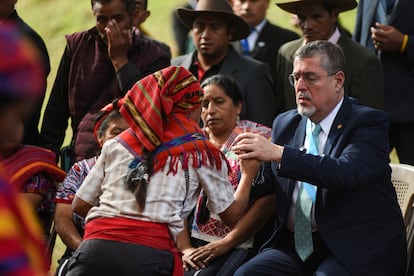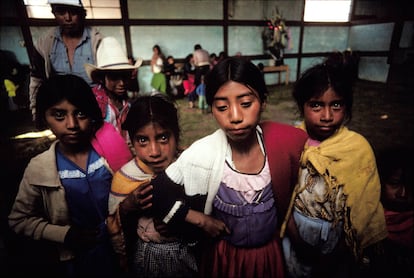Gabino Baltazar was studying education and natural medicine when he learned that, according to the Mayan calendar, his destiny lay in pedagogy and healing. Since that day, the rural professor from Huehuetenango, Guatemala, has concerned himself with the education of young people from his community. For the last three years, he has also attended to patients in his home. Although he would like to bring the knowledge of his ancestors, such as the medicinal plants with which he cured his mother, the benefits of knowing “each one’s destiny” and explanations of energetic implications to other audiences, he has been limited in that mission by the fact that his degree, for which he studied seven years, “doesn’t count” when it comes to hospital appointments. “In eight years, I’ll retire as an educator and I would love to be certified before that, so that I can set up my own clinic. There is a great need in the territories,” he says in a phone interview. “Cities are also losing all of our knowledge.”
In Guatemala, there are six Mayan universities: Ixil, Kaqchikel, Chorti, Poqomchi, Qeqchi, and Iniciativa Mam. All are propelled by the same basic objective: “Expanding our knowledge beyond oral tradition,” says Vitalino Similox, rector of the Maya Kaqchikel University, one of the centers of higher learning that have been designed for the Indigenous community. In Guatemala, this population comprises more than 60% of the country, though it continues to be referred to as “ethnic minorities.” Despite their efforts, and the fact that international regulation is on their side in recognizing their rights and worldview, none of these schools have been able to certify their degree programs. In their eyes, this has much to do with the historical racism from which their people have long suffered.
Guatemala is home to 17 million inhabitants hailing from 21 Mayan communities, plus the Xinka and Garifuna communities and individuals of mixed heritage. Over the last century, two extremely important historical processes for these peoples have taken place: the democratic period and the signing of peace agreements after a long civil war. Until 1944, the Central American country had no regulations ensuring the political participation of Indigenous communities. Twelve years later, with the ratification of the peace accords — in particular, the Agreement on the Identity and Rights of Indigenous People — the state recognized that the country’s armed conflict led to widespread displacement and racism towards Indigenous communities.
From then on, Guatemala has been nominally committed to the participation of these communities in the elaboration and implementation of public, legislative, and administrative policies that affect them, as well as in the decisions, actions and measures related to the mitigation of historic, structural, socioeconomic, and political causes that gave rise to its internal armed conflict.
But to Similox, these promises have amounted to little more than words. “Racism is in my country’s structure. It’s time to rework the state, which is very centralist. And with a single government, that won’t be possible. It will be a slow change,” he says, referring to the election of President Bernardo Arévalo, which took place thanks to support from the country’s Indigenous movements. “We have seen Arévalo’s good intentions, he has a calling to help, but here, there is an elite that keeps things as they are,” he says.

“Our outlook is not economistic, but social”
Despite these challenges, Similox remains objective and optimistic when he speaks about the care that goes into this work. The school he runs offers six bachelor’s degrees: pedagogy, with its emphasis on Kaqchikel culture and language; general comprehensive medicine; rural sociology, with a specialization in interculturality; agricultural science engineering; business administration, and Mayan science, philosophy and technology. “We have our own way of producing knowledge, science and wisdom. We have our own languages and our own forms of justice, a different cosmovision of nature. We have a lot to offer,” he says in an interview that takes place by video call. “Our outlook is not economistic, but social.”
Indigenous or intercultural universities stem from the recognition of the rights of Indigenous people and the necessity of creating alternative academic models. The accords are based on documents like the United Nations Declaration on the Rights of Indigenous Peoples and on the Organization of American States’ Declaration on the Rights of Indigenous Peoples. Historically, public and private universities have excluded this population from the educational system, from representation among students and teachers to language and content that is used in curriculums. The plurality of Indigenous peoples has led to each school being designed differently. “It’s an enormous wealth that has been gradually lost,” says Similox. And it’s precisely due to this leakage of Native languages that he’s sure that “we cannot wait for the government.” The conviction has led him to take on his role at Maya Kaqchikel University, despite receiving no pay for his work.
While some of the intercultural schools may receive government funds, most, like the six Guatemalan institutions, are supported by the people themselves. Students pay teachers’ salaries, despite most coming from poverty. “My job is to give back to my people the opportunities that I had and that others did not,” says Similox. He is the author of the books Experiencia: investigación y aprendizaje en Universidad Maya Kaqchikel: Una propuesta espistemológica desde la Filosofía Maya (Experience: research and learning at Maya Kaqchikel Univerisity: An epistemological proposal from Mayan philosophy) and La participación y representación política de los pueblos mayas de Guatemala (Participation and political representation of Guatemala’s Mayan peoples).

The rector is proud of having introduced academic alternatives to typical university degrees. “We are an alternative to linear and finite development education that looks to eat the fruits of nature,” he says. “Here, we talk about the fullness of life, focus on education, respect, and harmony with nature. Our work is different.” This is why, in Baltazar’s medicine classes, they take a holistic look at the body and energy of each person that goes beyond the science of the Global North. “I feel like we are going further,” he says. According to his estimates, 75% of the content taught at his school is Native.
Mayans have made incalculable contributions to society. It is to them we owe the solar calendar, key architectural advancements such as the pyramids, the digit “0″ in mathematics, the cycles of Venus, as well as various stars and constellations, rubber, and chocolate. “It’s ironic that the entire world has learned from us and now, it doesn’t let us teach,” says Similox.
Sign up for our weekly newsletter to get more English-language news coverage from EL PAÍS USA Edition



